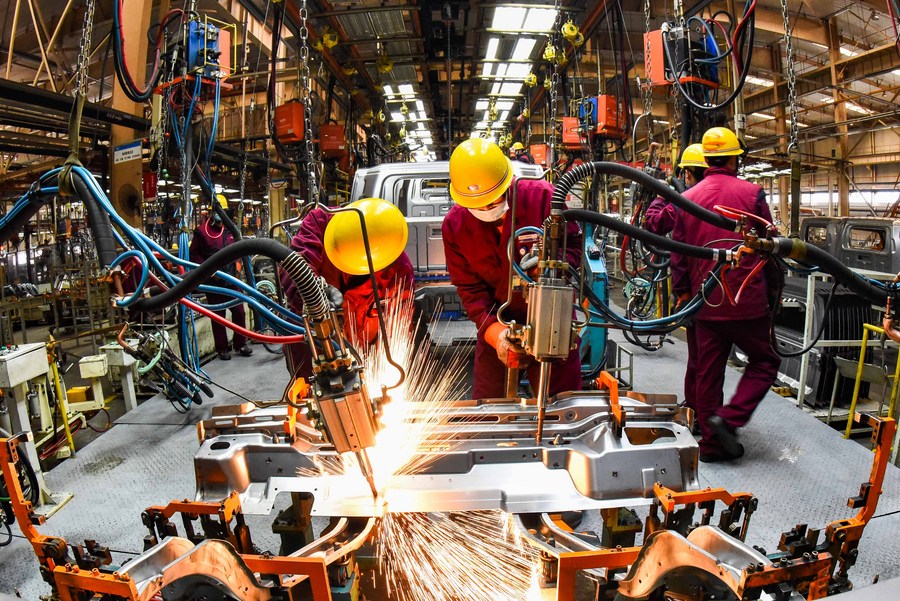Beijing (People's Daily) - The far-reaching supply chain disruptions are causing severe concerns worldwide over global growth and many people’s holiday season in the West. Many Americans who used to get their goods with a single click now find in shock the shortages of almost everything.

Workers weld components at a workshop of an automobile manufacturing enterprise in Qingzhou City, east China's Shandong Province, Feb. 28, 2021. (Photo: Xinhua)
Chinese experts on international economics expressed worries about the longer-than-expected disorder, while stressing China’s linchpin role in powering the global supply chain, in recent interviews with the People’s Daily.
China, as the world’s largest manufacturing hub, has played a huge role in stabilizing the global supply chain, said Liu Qing, an economics professor and deputy dean of National Academy of Development and Strategy of Renmin University of China.
Besides noting that the country’s effective COVID-19 prevention and control contributed to the global pandemic fight and the security of the supply chain, Liu added that China is a responsible partner in the global supply chain as it actively keeps trade and foreign investments stable, resumes production, fulfills international orders, and supports international transport during the pandemic.
Although impacted by extreme weather events, power crunch and sporadic COVID-19 infections, China’s exports expanded 22.7 percent year-on-year in the first three quarters of 2021, beating analysts’ expectations.
China has the world’s largest manufacturing system with the most complete categories and support facilities, and has formed a relatively independent and rounded industrial chain system, said Bai Ming, deputy director of the international market research institute at the Chinese Academy of International Trade and Economic Cooperation.
Maybe not every link in China’s industrial chain has reached the world’s best level, but there are no critical deficiencies and the chain can always keep operating, said Bai.
In a recent World Economic Outlook report, the International Monetary Fund has lowered its 2021 growth forecast for the world economy, given supply chain disruptions and pandemic concerns.
Experts pointed out the pandemic as a main cause of the supply chain chaos. The disparity of recovery among countries and links in the supply chain, and the demand-supply imbalance in the new round of industrial distribution exacerbated the problem.
The supply chain hiccups may not ease soon. As long as the world has not come out of the shadow of the pandemic, the crisis will not be fundamentally addressed, said Bai.
The global industrial chain and supply chain are facing enormous uncertainties and sluggish recovery from the pandemic. Some countries may push on self-reliance and attempt to reshape the supply chain landscape, analysts observed.
While adjustments cannot be made overnight, Liu said that China has both opportunities and challenges in the restructuring process of the global supply-chain.
The landscape of the global supply chain emphasizes cutting costs and managing risks, and stakeholders may next weigh more on risk management given the current problems, Liu explained. “A direct result is the supply chain will be more concentrated in the location of demand, presenting a trend of regionalization.”
“Since the Asian economy has the fastest development and largest market, there will be increasing production targeting this region,” said Liu. “In the future, considering risk control, manufacturing targeting the Asian market might be more and more concentrated towards China, especially the manufacture of high-end products which used to be made overseas.”
Meanwhile, some products for the western markets, which used to be made in China, might also be produced in European and American factories, according to Liu.
Despite a relatively complete industrial chain and a large-scale market in China, it does not mean the country has little participation in the international division of labor, said Bai.
China actively participates in the international division of labor, and must hold in its hands the initiative of some core areas, especially of those “bottleneck” technologies, added Bai.
(Chen Lidan contributed to the story.)


